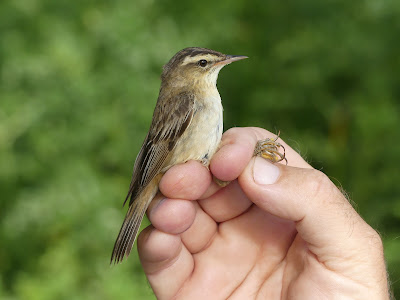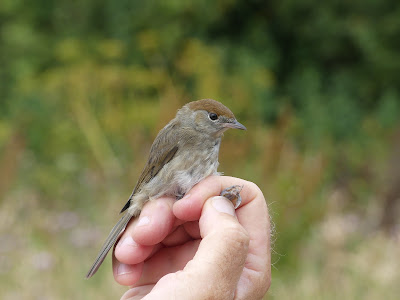The permissions and authorisation under schedule one licence were in place since last year, but due to the situation with Avian Influenza within other nearby colonies we postponed our first year marking the Little Tern chicks. The weather has a habit of being changeable so that also had us on tenterhooks as the day approached. We were hoping for a dry, cloudy day and that is what materialised, although extremely windy.
We assembled a 6 person team, organisers CL and DKL, DKH who is the warden at the point, ERB, PH and BD of the West Midlands Ringing Group who brought their thermal-imaging equipment.
DKH reported two days beforehand that 27 chicks had been counted when last surveyed, down from 43 a few days before and we feared that predation had been a problem. Having now ringed the young, and seen the range of ages present, some may have actually flown off prior to our ringing effort.
Three teams of two, each with their own rings and recording packs, started from the far end of the colony to avoid moving the young towards the area where Black-headed Gulls had been, although now most were gone. The thermal cameras worked well during the first sweep, with young marked and returned to where they were picked up as teams working in twos progressed steadily through the colony. A time limit had been set for each sweep to minimise disturbance and great care was taken as there were still nests with eggs and very small chicks.
We were very fortunate as there were no gulls, that may have tried to take chicks, present and we were able to complete both separate ringing sweeps without interruption. The shingle had warmed after the time out to allow normal tern activity to resume, and imagers were less helpful second time through the area. Some young were capable of weak flight, and there is every chance that a good percentage of marked young will fledge successfully very soon.
Three character alpha codes on yellow darvic rings were fitted in addition to metal rings.
Six chicks could only take a metal ring. We were all very pleased to fit darvics to 51 young Little Terns. These will be studied at the breeding site, via remote camera should they return as well as via the usual observation reporting opportunities for any bird carrying a darvic.
Many thanks to the National Trust for authorising the project, PD & BD for joining us from the Midlands and providing high tech kit, DKH for arranging access to the point and colony (saving us all a very long walk) and ERB for joining us. Photos by ERB, PH, BD & DKL.
Ringed under schedule 1 licence with all relevant bio-hazard precautions taken.
BCN with both rings in place and ready for release.
Totals:
Little Tern pulli - 57 (51 with darvic, 6 metal only)















































